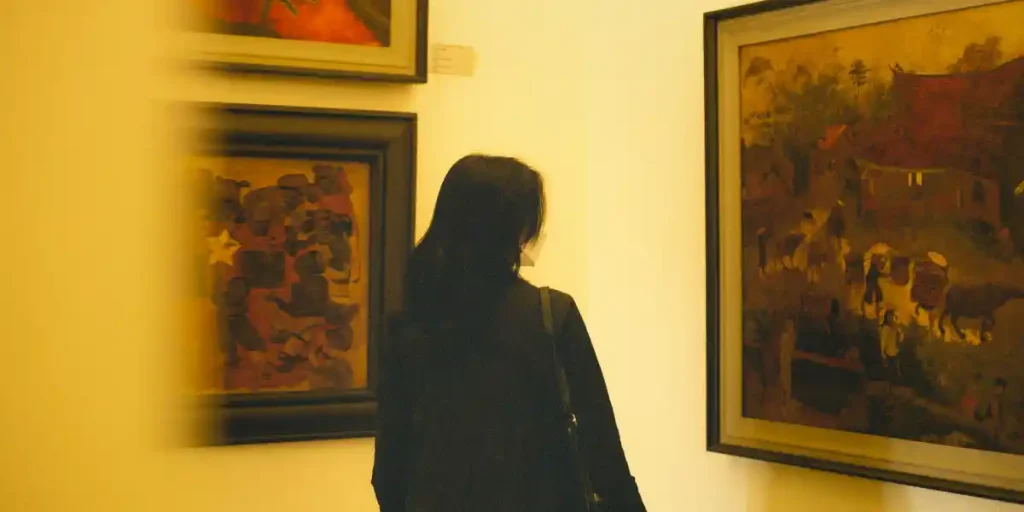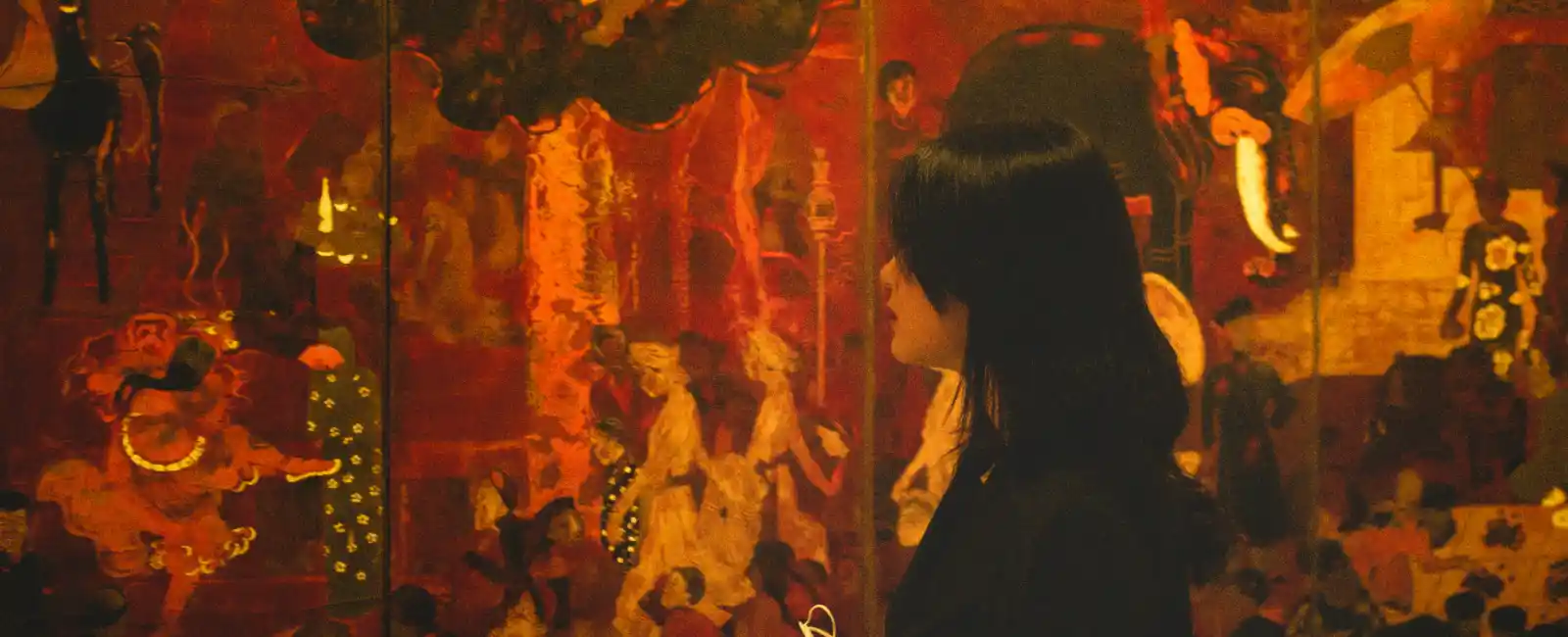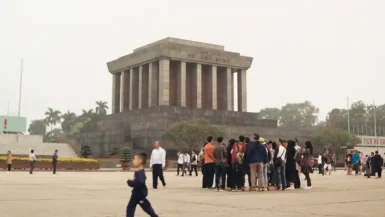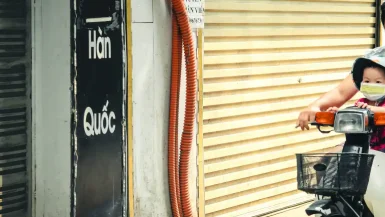Modern art in Vietnam is experiencing a vibrant cultural renaissance, blending traditional influences with contemporary styles. As a country with a deep artistic heritage, Vietnam has seen its art evolve through centuries, reflecting its dynamic history and diverse cultural influences. Today, modern art in Vietnam is not only a reflection of its past but also a bold statement of its present and future. In this article, we will delve into the exciting world of modern art in Vietnam, exploring its development, key figures, and the impact it has on both local and global stages.
The Evolution of Modern Art in Vietnam
Early Influences and Colonial Impact
Modern art in Vietnam began to take shape during the French colonial period. The establishment of the École des Beaux-Arts de l’Indochine in 1925 marked a significant turning point. This institution, located in Hanoi, introduced Western artistic techniques and concepts to Vietnamese artists. These early pioneers of modern art in Vietnam, such as Nguyễn Gia Trí and Tô Ngọc Vân, began experimenting with new styles while still rooted in traditional themes.
The influence of French Impressionism and Post-Impressionism was evident in their works. However, these artists did not merely imitate Western styles; they adapted them, blending them with Vietnamese subjects and aesthetics. This fusion of East and West laid the groundwork for the evolution of modern art in Vietnam.
The War Years: A Period of Struggle and Expression
The Vietnam War profoundly affected modern art in Vietnam. During this tumultuous period, artists used their work as a means of expression and resistance. Art became a powerful tool for communicating the emotions and experiences of a nation torn apart by conflict.
Painters like Bùi Xuân Phái, famous for his depictions of Hanoi’s old streets, captured the resilience of the Vietnamese people. Despite the war’s devastation, modern art in Vietnam continued to develop, with artists using their work to document the realities of war while maintaining a sense of hope and national identity.
Post-War Era: Rebirth and Reconciliation
The post-war era marked a new chapter for modern art in Vietnam. As the country began to rebuild, artists found new ways to express themselves. The Doi Moi reforms in the late 1980s, which opened Vietnam’s economy to the world, also brought about a cultural revival. These changes provided artists with more freedom to explore different styles and themes, leading to a flourishing of modern art in Vietnam.
During this period, artists began to experiment with abstract art, installation art, and other contemporary forms. They drew inspiration from both Vietnamese culture and global trends, creating a unique and diverse modern art scene in Vietnam.
Key Figures in Modern Art in Vietnam
Nguyễn Tư Nghiêm: A Pioneer of Vietnamese Modernism
Nguyễn Tư Nghiêm is one of the most celebrated figures in modern art in Vietnam. Born in 1922, Nghiêm was a student of the École des Beaux-Arts de l’Indochine. He is known for his bold use of color and his ability to blend traditional Vietnamese themes with modernist techniques.
His works often depict scenes from Vietnamese folklore and history, but with a modern twist. Nghiêm’s innovative approach to art has earned him recognition both in Vietnam and internationally. He remains a significant influence on younger generations of artists, and his contributions to modern art in Vietnam are immeasurable.
Nguyễn Tư Nghiêm’s works can be seen in several prominent locations in Vietnam, as well as in international collections. Here are a few key places where his art is displayed:
Vietnam National Fine Arts Museum (Bảo tàng Mỹ thuật Việt Nam), Hanoi
This museum holds an extensive collection of Vietnamese art, including several works by Nguyễn Tư Nghiêm. It’s one of the best places to see his paintings that depict traditional Vietnamese themes with a modernist flair.
Hanoi Museum (Bảo tàng Hà Nội), Hanoi
The Hanoi Museum showcases the cultural and artistic heritage of the city, and it includes works by prominent artists like Nguyễn Tư Nghiêm, reflecting his influence on modern Vietnamese art.
Ho Chi Minh City Museum of Fine Arts (Bảo tàng Mỹ thuật Thành phố Hồ Chí Minh), Ho Chi Minh City
This museum houses a variety of modern Vietnamese artworks, including pieces by Nguyễn Tư Nghiêm. It provides an excellent opportunity to explore his contributions alongside other contemporary artists.
Private Collections and Galleries
Many of Nguyễn Tư Nghiêm’s works are also held in private collections and may be featured in exhibitions at leading galleries in Vietnam and abroad, such as Art Vietnam Gallery in Hanoi and Galerie Quynh in Ho Chi Minh City.
International Exhibitions
Various international exhibitions have showcased Nguyễn Tư Nghiêm’s art, especially in France, where he enjoys a strong following due to his ties with the École des Beaux-Arts de l’Indochine. Exhibitions focusing on Southeast Asian modern art sometimes feature his work.
Visiting these locations will give you a deep insight into Nguyễn Tư Nghiêm’s legacy and the broader context of modern art in Vietnam.
Vũ Cao Đàm: Bridging Cultures Through Art
Vũ Cao Đàm, another prominent figure in modern art in Vietnam, was also trained at the École des Beaux-Arts de l’Indochine. However, his journey took him to France, where he became part of the Parisian art scene. Đàm’s work is a fascinating blend of Eastern and Western styles, reflecting his life between two cultures.
His sculptures and paintings often explore themes of identity, migration, and the blending of traditions. Vũ Cao Đàm’s work is a testament to the global reach of modern art in Vietnam, showing how Vietnamese artists contribute to the international art community while staying true to their roots.
Vũ Cao Đàm’s works are celebrated internationally and can be found in various prominent museums and collections around the world. Here are a few places where you can see his sculptures and paintings:
Museums and galleries
Musée d’Art Moderne de la Ville de Paris (Museum of Modern Art of the City of Paris)
Located in Paris, this museum has featured works by Vũ Cao Đàm, reflecting his influence in the Parisian art scene. His blend of Eastern and Western styles is well-suited to the museum’s collection of modern art.
Vietnam National Fine Arts Museum (Hanoi, Vietnam)
While Vũ Cao Đàm spent much of his career in France. Some of his works can also be seen in Vietnam’s National Fine Arts Museum. This museum showcases the rich history of Vietnamese art, including contributions from artists like Đàm.
Musée Cernuschi (Paris, France)
The Cernuschi Museum, specializing in Asian art, is another place in Paris where Vũ Cao Đàm’s work has been exhibited. His exploration of Vietnamese identity through a modern lens fits well within the museum’s focus.
Private Collections and Galleries
Vũ Cao Đàm’s work is also held in private collections and has been featured in galleries across Europe and Asia. Galleries such as Galerie Quynh in Vietnam and various Parisian galleries have exhibited his works over the years.
Auction Houses
Occasionally, Vũ Cao Đàm’s works appear in auctions at major houses like Christie’s and Sotheby’s. These sales often include pieces from private collections, giving a glimpse of his work to the public before they find new homes.
These locations offer a chance to view and appreciate the diverse and culturally rich art of Vũ Cao Đàm, a key figure in modern Vietnamese art.
Trần Lưu Hậu: A Master of Color and Form
Trần Lưu Hậu is another influential artist in the realm of modern art in Vietnam. Known for his abstract works, Hậu’s paintings are characterized by their vibrant colors and bold forms. His style, while distinctly modern, is deeply connected to his Vietnamese heritage.
Hậu’s work often explores the relationship between humans and nature, a theme that resonates with the traditional Vietnamese view of the world. His contributions to modern art in Vietnam have helped shape the country’s contemporary art scene, inspiring a new generation of artists.
Vietnam Fine Arts Museum (Bảo tàng Mỹ thuật Việt Nam) – Hanoi
The Vietnam Fine Arts Museum is one of the most important cultural institutions in Vietnam. It houses a collection of modern and contemporary Vietnamese art, including works by Trần Lưu Hậu. The museum is located in Hanoi and offers a comprehensive overview of the country’s artistic heritage.
Location: 66 Nguyễn Thái Học, Ba Đình, Hanoi, Vietnam
VCCA – Vincom Center for Contemporary Art – Hanoi
The VCCA is a leading contemporary art center in Hanoi.It frequently hosts exhibitions featuring prominent Vietnamese artists, including Trần Lưu Hậu. The center is prominent for its dynamic programming and commitment to showcasing both established and emerging artists.
Location: B1 – R3, Vincom Royal City, 72A Nguyễn Trãi, Thanh Xuân, Hanoi, Vietnam
Manzi Art Space – Hanoi
Manzi Art Space is a contemporary art space and cultural venue in Hanoi. While it is more intimate than the larger museums, Manzi often showcases the works of influential artists like Trần Lưu Hậu through exhibitions and special events.
Location: 14 Phan Huy Ích, Ba Đình, Hanoi, Vietnam

Art Vietnam Gallery – Hanoi
Art Vietnam Gallery is famous for its dedication to contemporary Vietnamese art. The gallery has exhibited works by Trần Lưu Hậu, among other significant Vietnamese artists. It serves as a hub for collectors and art enthusiasts interested in modern Vietnamese art.
Location: 2nd Floor, 24 Lý Quốc Sư, Hoàn Kiếm, Hanoi, Vietnam
Ho Chi Minh City Museum of Fine Arts (Bảo tàng Mỹ thuật TP. Hồ Chí Minh) – Ho Chi Minh City
This museum is a major repository of modern and contemporary Vietnamese art. It occasionally features works by Trần Lưu Hậu as part of its extensive collection. The museum is a must-visit for those interested in exploring Vietnam’s modern art scene.
Location: 97A Phó Đức Chính, District 1, Ho Chi Minh City, Vietnam
International Exhibitions and Art Fairs
Trần Lưu Hậu’s works have also been exhibited internationally, in art fairs, galleries, and museums around the world. Keeping an eye on international art exhibitions featuring Vietnamese artists can provide opportunities to see his work outside of Vietnam.
These locations provide a rich context for experiencing Trần Lưu Hậu’s contribution to modern art in Vietnam. Whether you’re visiting a large museum or a more intimate gallery, each venue offers a unique perspective on his vibrant and culturally resonant artwork.
Contemporary Trends in Modern Art in Vietnam
The Rise of Installation Art and Multimedia
In recent years, installation art and multimedia have become prominent forms of modern art in Vietnam. Artists like Dinh Q. Lê and Nguyễn Phương Linh have gained international recognition for their innovative works. These artists often tackle complex themes such as identity, memory, and the effects of globalization on Vietnamese society.
Installation art allows these artists to create immersive experiences that challenge the viewer’s perceptions. By using various media, they can explore the intersections of past and present, traditional and modern, in a way that is uniquely Vietnamese.
The Role of Galleries and Art Spaces
The growth of modern art in Vietnam has been supported by a burgeoning network of galleries and art spaces. Cities like Hanoi and Ho Chi Minh City are home to numerous galleries that showcase the work of both emerging and established artists. These spaces play a crucial role in promoting modern art in Vietnam, providing a platform for artists to experiment and engage with the public.
Galleries like Galerie Quynh in Ho Chi Minh City and Manzi Art Space in Hanoi are at the forefront of this movement.
The Influence of Globalization and Technology
Globalization and technology have also significantly impacted modern art in Vietnam. The internet and social media have allowed Vietnamese artists to connect with a global audience, share their work, and draw inspiration from international trends. This has led to a more dynamic and diverse art scene, where traditional Vietnamese elements are combined with contemporary global influences.
Moreover, technology has opened up new possibilities for artistic expression. Digital art, video art, and interactive installations are becoming more common in modern art in Vietnam, reflecting the country’s embrace of innovation and change.
The Impact of Modern Art in Vietnam on Global Art
Modern art in Vietnam is not only shaping the cultural landscape within the country but also making a significant impact on the global art scene. Vietnamese artists are increasingly participating in international exhibitions, biennales, and art fairs, bringing their unique perspectives to a wider audience.
The themes explored in modern art in Vietnam, such as identity, memory, and the effects of historical events, resonate with global audiences. This has led to a growing interest in Vietnamese art, with collectors and institutions around the world seeking out works by Vietnamese artists.
Vietnamese art has also gained recognition in academic circles, with scholars studying the evolution of modern art in Vietnam and its place within the broader context of Southeast Asian art. This academic interest further solidifies the importance of modern art in Vietnam on the global stage.
The Future of Modern Art in Vietnam
The future looks bright, with a new generation of artists continuing to push boundaries and explore new forms of expression. As the country continues to develop economically and culturally, modern art in Vietnam will likely become even more diverse and innovative.
Education will play a key role in this development. Vietnamese art schools now teach contemporary practices, preparing new artists for the modern art scene. Government and private support is crucial for modern art’s growth.
The future also holds exciting possibilities for collaboration between Vietnamese and international artists. Such collaborations will not only enhance the global profile of modern art in Vietnam but also lead to the creation of new, cross-cultural works that reflect the increasingly interconnected world.
Conclusion: Embracing the Modern Art Renaissance in Vietnam
Modern art in Vietnam showcases the country’s rich cultural heritage. It reflects the nation’s ability to adapt and innovate. Early influences include French colonialism, shaping a dynamic and diverse art scene today. Modern art in Vietnam embodies a nation that values tradition while embracing the future.
As it evolves, modern art in Vietnam shapes the country’s cultural identity. Art enthusiasts, collectors, and scholars find endless inspiration in Vietnam’s modern art scene. This art provides insight into the complex world of Vietnamese culture.
Whether you’re an art lover, traveler, or curious about new cultures, modern art in Vietnam offers a unique experience. Exploring Vietnamese art reveals a creative spirit deeply rooted in tradition. It is also boldly innovative, making modern art in Vietnam a captivating subject.



